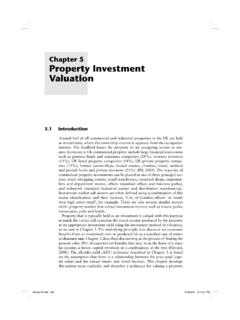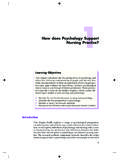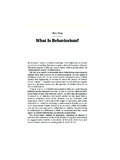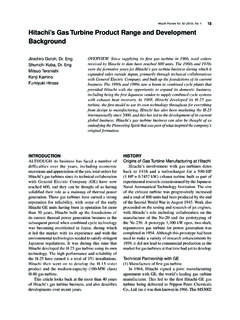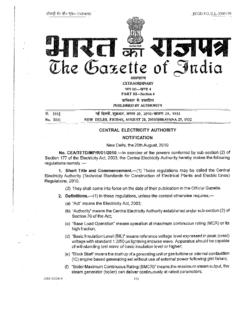Transcription of Case 15 GENERAL ELECTRIC: LIFE AFTER JACK
1 Case 15 general electric : life AFTER jack * When Jeff Immelt took over as Chairman and CEO of GENERAL electric on September 1, 2001, he had no doubts that his predecessor, jack Welch living legend, best manager of the past half-century would be a tough act to follow. But little did he realize just how tough it would be. When Immelt addressed GE shareholders at the 2002 share owners annual conference on April 24, 2002, GE s share price was below $33, compared with a peak of $60 in August 2000. GE was suffering from external events such as the global economic slowdown of 2001 and the fallout from the September 11 terrorist attacks in the US, but the primary problem was a rise of tide of skepticism over GE s spectacular performance. In February 2002, GE announced record earnings for the previous year net income was up 11 percent over the previous year and return on equity was a robust 26 percent. However, the post-Enron wave of cynicism over corporate financial reporting had dawn GE into its wake.
2 AFTER being lauded by analysts for its smooth earning growth, rumors of earnings manipulation by GE circulated among the investment community. More specific criticisms were directed at the way in which GE was able to disguise the true risks of its businesses by consolidating the financial statements of its industrial businesses within its financial services business, GE Capital). In March 2002, Bill Gross, of the IPCO fund management group, showed that GE was more a financial services rather than an industrial company, however, by supporting GE Capital with its industrial business, GE Capital had been able to operate on a narrow capital base and maintain a triple-A credit rating. In addition, GE s famously reliable earnings estimates were also subject to doubt. Given the slowing demand affecting several of GE s industrial business, there was concern that 2002 earnings estimate would be achieved only through manipulating the earnings data.
3 While investors held little hope that Immelt could ever match the incredible 50-fold increase in GE s market value that Welch had achieved, the management community was more interested in the changes in corporate strategy, organizational structure, and management systems that Immelt would initiate. Welch had been a revolutionary and an autocrat. He had swept away most of GE carefully constructed structure and its greatly admired corporate planning system. He had relentlessly challenged GE managers for improved operational and financial performance, he had created a GE management style based almost entirely upon his own personality, values, and beliefs. His management innovations at GE had exerted a huge impact upon management thinking and management practices throughout the whole corporate sector. Whole course at business schools had been devoted to GE s approach to strategic planning, human resource management, knowledge management, international management, acquisition management, financial management, and quality management.
4 In the short term Immelt knew that his number one priority was to restore the confidence of the investment community in GENERAL electric , particularly in relation to its financial structure and financial reporting. But looking further ahead, Immelt realized that his primary challenge was coming to terms with Welch s legacy at GE. Each of GE s CEOs had been associated with successfully adapting GE s strategy and management systems to the challenges of the particular era. Between 1950 and 1963, Ralph Cordiner had responded to the opportunities of post-war growth to diversify GE into a range of new markets and new technologies. His successor, Fred Borsch (1963-72) had reorganized GE around nine major growth sectors within which each business formed a strategic business unit. During 1972 to 1981, Reginald Jones established GE s highly regarded and widely imitated system of strategic and financial planning which reconciled strong central control with high levels of operational autonomy for divisions and business units.
5 jack Welch s contribution had been to adapt GE to a world of uncertainty, intense competition and rapid competition. In building an organization and a management culture which reconciled the benefits of massive corporate size with flexibility and responsiveness, Welch undid much of Jones s management systems in favor of a system based upon personal accountability and high levels of performance expectations. GENERAL electric COMPANY The GENERAL electric (GE) that Jeffrey Immelt inherited in 2001 was widely regarded as one of the world s most successful companies of all time. It is the only company to have remained a member of the Dow Jones 30 share industrial index since the index was first created. Throughout its history, it has been associated with near-continuous growth and above average profitability. Table shows profitability under successive CEOs. [Table about here] GE was founded in 1892 from the merger of Thomas Edison s electric Light Company with the Thomas Houston Company.
6 Its business based upon exploiting Edison s patents relating to electricity generation and distribution, * Copyright 2002 Robert M. Grant light bulbs, and electric motors. During the twentieth century it became not only the biggest and most diversified industrial corporation in America, but a model of management a laboratory studied by business schools and raided by other companies seeking skilled executives. 1 Two decades under jack Welch s leadership had only enhanced GE s reputation for effective management. In 2001, Fortune magazine named GE as America s most admired company for the fifth year in succession, and the Financial Times identifies GE as the world s most respected company for the fourth consecutive year. GE was not only one of the world s biggest companies, it was also one of the worlds most diverse. While most of the conglomerates of the 1980s Hanson, ITT, Seagram, Philips, GENERAL Mills, and United Technologies had either undergone massive refocusing or broken themselves up entirely, GE had remained a broadly diversified company spanning a wide range of businesses from jet engines to mortgage banking.
7 Figure shows GE s major businesses. [Figure about here] GE s ability to thrive as a broadly diversified corporation was one of the wonders of the business world. Since the early 1990s, diversified firms had been handicapped by the conglomerate discount the capital markets had capitalized their earnings at lower multiples than for single-business companies. The only solution was to refocusing or break-up. For GE this issue has never arisen, GE s remarkable financial performance was such that it had never been under pressure to spin off individual businesses or dismember itself completely. This superior performance is evident in GE s capacity to achieve both growth and profitability throughout the economic cycle (see Table ), and its financial stability GE had maintained its triple-A credit rating for 44 consecutive years. [Table about here] As Immelt emphasized to shareholders, it was the combination of these different businesses with their different cyclical characteristics that allowed GE to sustain its earning growth: We have four strong, powerful long cycle businesses: Power, Medical, Engines, and Transportation.
8 These businesses are strong, number one, with multiple levers to grow earnings through technology and services. Our Power business had led the way through the past few years of gas turbine growth and as that turbine market subsides, our Power business will thrive by servicing an installed base that has grown five-fold. Our Medical franchise has unlimited opportunities driven by world-class technology, favorable demographics, and global distribution. Our Aircraft Engines business gets even stronger every year as we continue to invest in new engine platforms and technology. The importance of these long cycle business is tat give you steady earnings growth over time, with stable product cycles abs rapid service growth. We also have a leadership franchise in our short cycle businesses, like NBC, Plastics, Materials, Consumer, and Industrial businesses. These have been hardest hit by the downturn but so far in 2002 we are seeing encouraging signs of We have the world s most diversified financial service business with consumer finance, mid-market financing, insurance, equipment management, and specialty segments.
9 We re growing assets at GE Capital by 15 importance of GE Capital is that it can use GE s financial and industrial strength to generate superior returns over The GE portfolio was put together for a purpose to deliver earnings growth through every economic cycle. We re constantly managing these cycles in a business where the sum exceeds the However, for all the emphasis on the complementary performance characteristics of GE s different businesses, it was also apparent that there were clear differences in terms of both growth and profitability between them (Table ). [Table about here] THE WELCH HERITAGE This ability of GE, not just to drive performance in the individual businesses, but also to create a corporation where the sum exceeds the parts was the hallmark of jack Welch s tenure as GE s chairman and CEO. Welch s contributions to the restructuring of GE s business portfolio, its organizational design, and its management systems will be described in subsequent sections, underlying all these contributions was Welch s revolutionary impact on GE s culture and its management style.
10 During his 20-year tenure, Welch had remade GE in his own image. The culture and management style that he had fostered were reflections of his own personality and values. Welch attributes his management style t two formative influences: his mother and ice hockey. Welch credits his mother wit nurturing self confidence, determination, and strong values. He credits ice hockey with developing competitive spirit, confrontation and camaraderie. From the outset, Welch set lofty goals for GE: in 1981, as the newly-appointed chairman and chief executive, he outlined his vision: A decade from now I would like GENERAL electric to be perceived as a unique, high-spirited, entrepreneurial company known around the world for its unmatched level of excellence. I want GENERAL electric to be the most profitable, highly diversified company on earth, with world-quality leadership in every one of its product lines. For 20 years, Welch continually pushed his subordinates for more.

